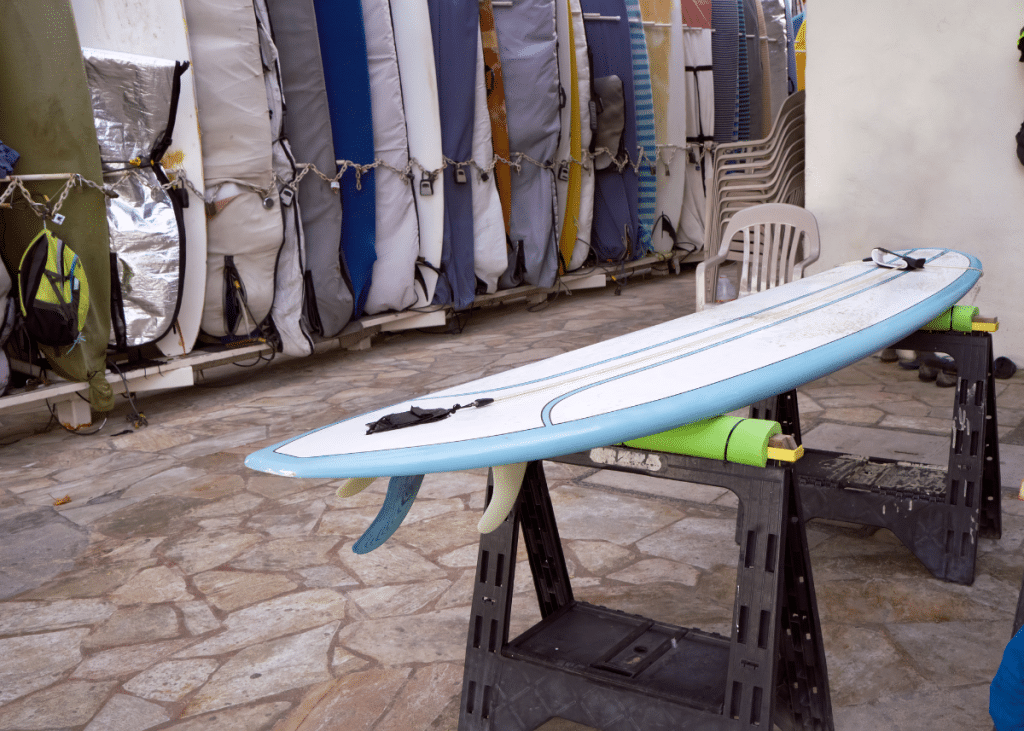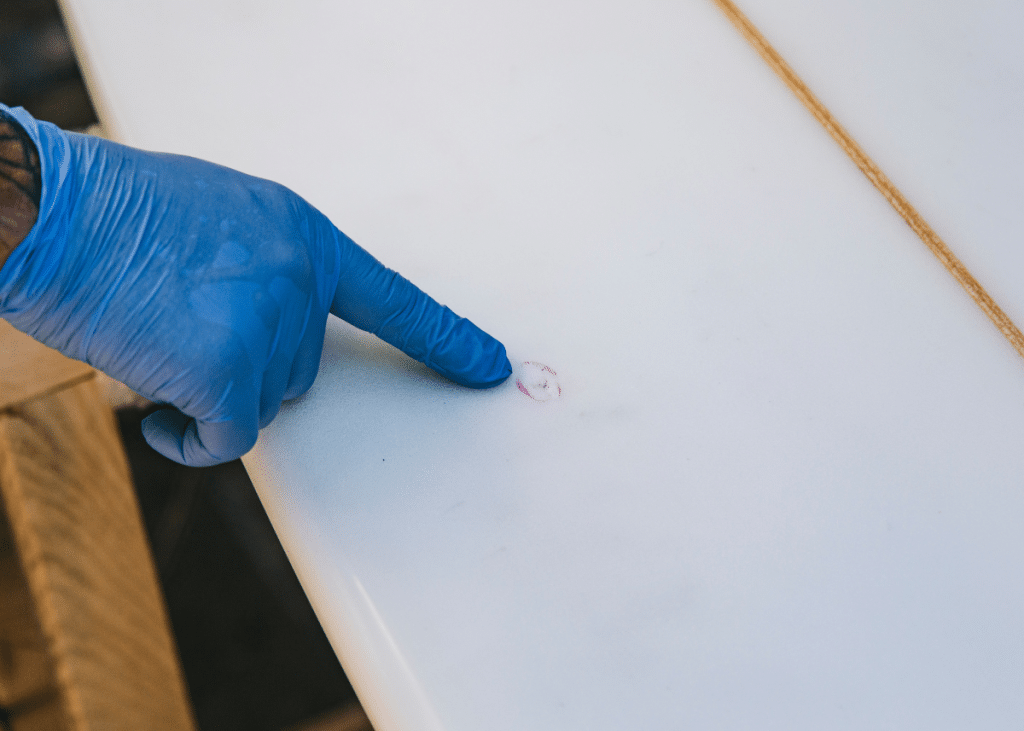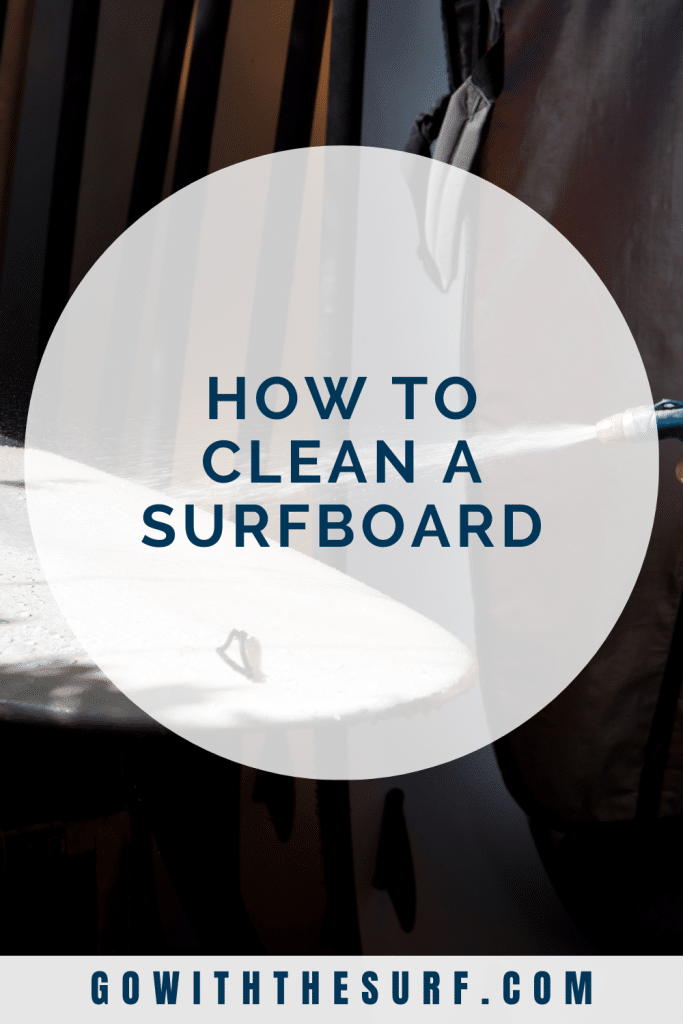How to Clean a Surfboard: Quick and Easy Maintenance Tips
Keeping your surfboard clean is essential for maintaining its performance and longevity. Let’s go over some quick and easy maintenance tips to help you keep your board in top shape so you can catch those gnarly waves with ease.
Whether you’re a seasoned pro or a beginner surfer, proper care of your surfboard is key to enjoying endless hours of fun in the water. Let’s dive in and learn how to keep your surfboard sparkling clean!
This post contains affiliate links, which means I receive a small commission, at no extra cost to you, if you make a purchase using this link. Please see my disclosure for more details.
Essentials of Surfboard Maintenance
Maintaining your surfboard isn’t just about keeping it looking good; it’s about preserving its performance and extending the lifespan of your board. Here’s a straightforward guide to ensure your board remains in top shape:
- Rinse Regularly: After every session, cleanse your surfboard with fresh water to remove salt and sand, which can degrade the board materials over time.
- Remove Old Wax: Wax build-up can make your board heavy and may affect its balance. Use a plastic credit card or wax comb to scrape off the old wax every now and then.
- Wax Application: Apply a fresh layer of new wax as needed. This ensures optimal grip and enhances your control on the waves.
- Drying: After rinsing, pat the surfboard dry with a clean cloth. Let it air dry but avoid direct sunlight as UV rays can damage the surfboard’s material.
- Storage: Store your surfboard in a cool, shaded area. Do not rest it on hard surfaces where it can sustain dings or pressure dents.
Remember, this routine care can make all the difference in your surfing experience and safeguard your investment.
Preparing for Cleaning
Before diving into the surfboard cleaning process, your success hinges on careful preparation.
The first step is to make sure you have the right tools and environment ready to avoid frustration and achieve the best results.
Gather Supplies
Firstly, you’ll need to assemble all the necessary supplies. Your cleaning arsenal should include:
- A wax comb or an old credit card for scraping
- A clean rag or cloth
- Warm water in a bucket or container
- Surfboard cleaner or mild detergent (optional)
- WD40 or coconut oil for residue removal
- A small trash bag for old wax and debris
- Towels
Initial Rinse
Begin by giving your board a quick rinse with fresh water. This step helps to rinse off the salt water and remove loose dirt, salt, or sand that can otherwise act as abrasives when you’re cleaning the surface of your board.
Preparing the Work Area
Choose a flat, stable surface where you’ll clean your board. Clear the area of any objects that might damage your surfboard or hinder your movement around it. A soft surface such as grass or a rubber mat can prevent dings and scratches during the cleaning process.
Shade and Timing
Opt to clean your board in a shaded area to prevent the wax from melting too rapidly during the process. The ideal time for cleaning is either early morning or late afternoon when the temperatures are cooler. Or time your surfboard cleaning for a cloudy day. If using the sun to help soften the wax, make certain to manage the exposure time to avoid overheating the surface of your surfboard.

Removing Wax
Before riding the waves, it’s essential to maintain the optimal condition of your surfboard by regularly removing the old wax. This will ensure you have the best grip and performance from your board.
Softening the Wax
To begin, you need to soften the old wax on your surfboard to make it easier to remove. Here’s how you can do it:
- Place your board in direct sunlight for 10-15 minutes. The warmth will make the wax shine and turn slightly gooey.
- If there’s no sunshine, use a hairdryer to gently heat the wax surface until it softens.
Scraping the Wax Off
Once the wax is softened, follow these steps to scrape it off:
- Use a wax comb or an old plastic credit card.
- Starting from the top of the board, gently remove the old surf wax using the sharp edge of the comb.
- Work your way down to the bottom, being careful not to damage the board’s surface.
- Discard removed wax in a small trash bag to keep the area clean.
Detailed Cleaning Steps
Before you start, ensure your surfboard is out of direct sunlight and you have your cleaning materials at hand. Adequate preparation will make the cleaning process efficient and effective.
Apply the Cleaner
First, prepare your cleaner, which can be a specialized surfboard cleaning solution or a mix of mild soap and water. Dampen a clean cloth with your chosen cleaner and gently apply it to the surface of the board. You may use a circular motion to evenly distribute the cleaner.
Scrubbing the Board
With a soft-bristle brush or a clean cloth, gently scrub the board to remove dirt, grime, and any wax residue. Concentrate on areas where dirt accumulates the most, often around the rails, nose, and tail. If your board had wax on it, using a wax comb will help lift and remove the majority of it before scrubbing.
Rinsing Off Soap
After thoroughly scrubbing the board, rinse it with fresh water. Be sure to remove all soap residues, as any leftover cleaner can affect the board’s grip. Use a towel or a clean cloth to dry your surfboard immediately after rinsing to avoid water spots.
Inspecting and Repairing Dings
When you inspect your surfboard for dings, it’s all about catching the minor issues before they become major problems. You’ll learn to identify signs of damage and get handy DIY repair tips to keep your board in top shape.
Identifying Signs of Damage
To ensure your surfboard is always ready for the water, regular inspections are crucial. Look for cracks, punctures, or any separation between the fiberglass and the foam core, as these are signs of dings. Here’s what to look for:
- Cracks: Hairline or larger cracks on the surface
- Punctures: Small or large holes that can potentially let water in
- Delamination: Areas where the fiberglass has come away from the foam
DIY Repair Tips
If you’ve found a ding in your surfboard, timely repairs are essential to prevent water damage and maintain board integrity. Try keeping a surfboard repair kit handy for these moments. Here’s a brief guide on how to fix a ding yourself:
- Clean the Area: Thoroughly clean the ding with soap and water. Remove any wax with a wax comb or similar tool.
- Dry and Prepare: Dry the area completely. Sand around the ding to create a rough surface for better resin adhesion.
- Resin Application: Apply resin to the ding. If the color of your board is unique, consider using a color-matched resin.
- Curing: Allow the resin to cure as directed.
- Finishing Touches: Sand the cured resin until it’s smooth and flush with the surrounding area of the surfboard.

Drying and Storage
After cleaning your surfboard, the final step is to dry it thoroughly and store it correctly to maintain its condition for future use.
Drying the Board
Once your surfboard is clean, gently pat it down with a clean towel to remove excess water. It’s important to leave it out to air dry completely, but not in direct sunlight as it could damage the board. Ideally, dry your clean board in a shaded, cool area with good air circulation to prevent any potential warping or delamination.
Proper Storage Methods
When your surfboard is dry, store it in a cool, dry place away from direct sunlight and extreme temperatures. Upside down on a rack is best to avoid pressure dings on the deck. If you’re lacking a rack, you can place your board on its side – just ensure it’s not resting on its fins to prevent them from warping.
Consider a padded board bag for added protection against dust and accidental knocks.
Protective Measures for Your Surfboard
Taking care of your surfboard extends beyond just cleaning; you need to protect it from everyday wear and tear and environmental factors that could shorten its lifespan.
Using Board Bags
A board bag is essential for safeguarding your surfboard during transport and when not in use. Here’s what you need to know:
- Storage: Store your surfboard in a board bag to shield it from physical damage like dents and scratches.
- Travel: During travel, a padded board bag prevents major damage if your board is accidentally knocked or dropped.
Applying UV Protectors
Exposure to UV rays can degrade your surfboard’s materials over time. Here’s how to keep your board safe from the sun:
- UV-resistant Wax: Opt for a wax that provides a UV protective layer to block harmful rays.
- Surfboard Sunscreen: Some products can be applied directly onto the board to protect it from sun damage, much like sunscreen for your skin.

Regular Maintenance Schedule
To keep your surfboard in top condition, follow a regular maintenance schedule.
Daily Care: Post-Surf Ritual
- Rinse: After each use, rinse your board with fresh water to remove salt and sand.
- Dry: Use a soft towel to dry or allow to air dry in the shade.
- Inspect: Check for dings and cracks, repairing them quickly to avoid water damage.
Weekly Maintenance: Wax and More
- De-wax: Using a wax comb or plastic card, carefully remove the old layer of wax.
- Clean: Wipe the entire surface with a soft cloth. For stubborn areas, consider using a surfboard cleaner or a gentle alternative like coconut oil.
Tip: Store your board in a cool, shaded area when not in use.
Monthly Check-Up: Deep Clean
- Thorough wash: Give your board a deeper clean, focusing on any wax residue.
- Fin check: Make sure fins are secure and free of damage.
- Wax reapplication: After cleaning, apply a fresh coat of wax for optimal grip.
Seasonal Care: Storage and Handling
- Assess: Before extended storage, do a comprehensive check-up and repair any issues.
- Protection: Invest in a good-quality surfboard bag to prevent scratches and UV damage.
Remember, consistency in caring for your board ensures its longevity and performance in the water.

Frequently Asked Questions about Cleaning Your Surfboard
What’s the best way to get rid of old wax on my surfboard?
The most effective method to remove old wax is to leave your board in the sun for a few minutes until the wax softens, then use a wax comb with serrated and flat sides to scrape it off gently.
Can I remove surfboard wax without using a comb?
Yes, you can. If you don’t have a wax comb, using a plastic credit card or similar plastic edge can work as a substitute to scrape away the wax.
Is it okay to use household cleaning products like Windex on my surfboard?
It’s not recommended to use household glass cleaners like Windex on your surfboard as they may contain chemicals that can damage the board’s finish. Stick to a surfboard cleaner or mild soap.
How often should I be cleaning my surfboard?
Clean your surfboard after each use to prevent saltwater and sand from causing damage. A thorough wax removal and deep clean can be done every few months depending on your frequency of use.
What are some effective homemade alternatives to surfboard wax removers?
Homemade solutions like mixing equal parts of white vinegar and water, or using coconut oil, can assist in loosening the wax for easier removal.
Will rubbing alcohol help in removing wax from my surfboard?
Rubbing alcohol can help in cleaning the residues left after wax removal, but it should be used with caution. It can dry out the foam if your surfboard is of the epoxy or foam variety. Use it sparingly.
Conclusion
Now that you’ve learned these quick and easy maintenance tips, you’re all set to keep your surfboard in great condition. By regularly cleaning and maintaining your board, you can ensure that it stays in top shape for many surf sessions to come.
Remember, a clean surfboard not only looks great but also performs at its best, allowing you to ride the waves with confidence. So, grab your board, hit the waves, and enjoy the thrill of surfing knowing that your trusty companion is well taken care of!

Anh
Anh recently retired at the age of 35 and moved to a small surf town in Portugal in 2023. She started surfing as a hobby, but she fell in love with the water sport. She shares her tips and tricks with fellow surfers at Go With the Surf.












